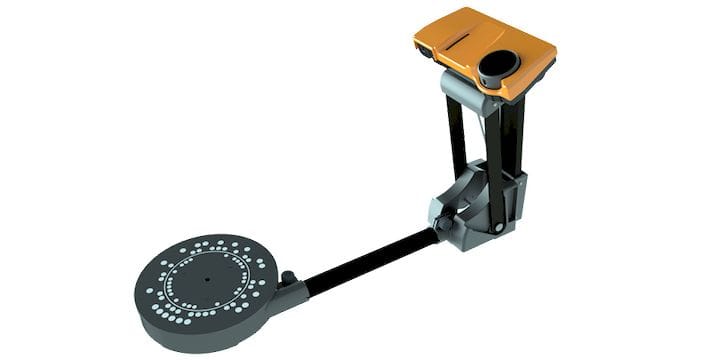![The SOL 3D Scanner [Source: Scan Dimension]](https://fabbaloo.com/wp-content/uploads/2020/05/image-asset_img_5eb099612eb20.jpg)
Scan Dimension has released a new tabletop 3D scanner, the SOL.
The device is a tabletop design, meaning it has an attached scanning platform and a fixed scanning head. You place the subject to be scanned on the platform, which rotates it in front of the scanning head. Software does the rest.
The specifications for the device are few, but we do know it:
-
Has an “accuracy” up to 0.1mm
-
Can handle objects of up to 100mm or 170mm tall, depending on the configuration of the device
-
Weighs 3.5kg
-
Includes two USB cables
-
Comes with a tent
And that’s about it. I’m a little perplexed by the “accuracy” of 0.1mm, as that is not how 3D scanning specifications are typically portrayed. Usually there is a “positioning accuracy”, which indicates how close to reality the scanner is placed, and a “resolution” that shows the smallest possible scannable element. I suspect Scan Dimension here means the latter.
They don’t say what 3D scanning process is employed here. It could be lasers, infrared array, photogrammetry or some other technique. However, by examining images of the device we can do some speculation.
![Curious white marks on the SOL 3D scanner’s platform [Source: Scan Dimension]](https://fabbaloo.com/wp-content/uploads/2020/05/image-asset_img_5eb09961883df.jpg)
On the scanning platform you can see some curious white marks. These are irregular and placed in such a way as to ensure at least some of them are visible regardless of the orientation of the scanning subject.
This suggests to me that they are using a photogrammetry approach, where the white marks are used as the cues for the software to detect and measure the slow rotation of the subject. That’s how photogrammetry works: take a series of images from all around a subject, and the software observes how the background slightly changes to estimate how the object is placed in 3D space.
If it is photogrammetry, then the scanning head is a digital camera. We also know that one accessory included in the package is a “Black-out tent with enclosure”. This tells me that the system is best operated in the dark, courtesy of the tent. It also suggests that the scanning head includes a uniform lighting system.
There is a laser involved in the SOL system as well, as they say:
“SOL captures multiple images and spatial data via its camera and laser to make an accurate digital replica.”
![Example of a 3D scan produced by the SOL 3D scanner [Source: Scan Dimension]](https://fabbaloo.com/wp-content/uploads/2020/05/image-asset_img_5eb09961d5e2c.jpg)
It’s not clear what role the laser plays in the process, but perhaps by combining photogrammetry and laser distance measurements they can compute a more accurate 3D representation?
Now that we know something about the SOL, I suspect that it may actually work reasonably well simply because of the black-out tent approach. Tabletop scanners can be very tricky to operate, as they are often confused by reflections and extraneous patterns in the view. These would be eliminated by the tent.
Shiny objects are also highly problematic for most 3D scanning systems. I am thinking that the black-out approach used by the SOL may actually help with this, as there would be no weirdly changing reflections as the object rotates: the black tent gets rid of any such reflected light. However, there’s that curious laser that may generate some reflections. Scan Dimension is silent on the topic of reflective subjects.
How about the software? Scan Dimension explains:
“Our vision is to engineer an incredibly accurate scanner, enabled with the single push of a button, at a price most anyone can afford. Once SOL is connected to your computer, and calibrated, just place your object on the turn-table, cover it with the already included tent, and let SOL do its magic!”
They must have some sort of one-touch system where the generated point cloud is automatically converted to a solid 3D mesh object, and hopefully perform some kind of repairs. This is because 3D scans inevitably are full of holes and often require considerable effort to repair. If this works properly, then that could be a huge timesaver when working with the SOL.
But the best feature of this device is the price: it’s listed at only US$599, a very low price for a 3D scanner of any type. Even better, they seem to have a launch price discount of US$50, so the current price is only US$549.
If you feel you may need a tabletop 3D scanner, the SOL may be something to check out.
Via Scan Dimension











